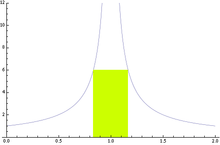Lorentz space

 is the area of the largest rectangle with sides parallel to the coordinate axes that can be inscribed in the graph.
is the area of the largest rectangle with sides parallel to the coordinate axes that can be inscribed in the graph.In mathematical analysis, Lorentz spaces, introduced by George Lorentz in the 1950s,[1][2] are generalisations of the more familiar Lp spaces.
The Lorentz spaces are denoted by Lp,q. Like the Lp spaces, they are characterized by a norm (technically a quasinorm) that encodes information about the "size" of a function, just as the Lp norm does. The two basic qualitative notions of "size" of a function are: how tall is graph of the function, and how spread out is it. The Lorentz norms provide tighter control over both qualities than the Lp norms, by exponentially rescaling the measure in both the range (the p) and the domain (the q). The Lorentz norms, like the Lp norms, are invariant under arbitrary rearrangements of the values of a function.
Definition
The Lorentz space on a measure space (X,μ) is the space of complex-valued measurable functions ƒ on X such that the following quasinorm is finite
where 0 < p < ∞ and 0 < q ≤ ∞. Thus, when q < ∞,
and when q = ∞,
It is also conventional to set L∞,∞(X,μ) = L∞(X,μ).
Decreasing rearrangements
The quasinorm is invariant under rearranging the values of the function ƒ, essentially by definition. In particular, given a complex-valued measurable function ƒ defined on a measure space, (X, μ), its decreasing rearrangement function, ![f^{{*}}:[0,\infty )\rightarrow [0,\infty ]](/2014-wikipedia_en_all_02_2014/I/media/1/2/3/8/1238d99c022671223a8f6d69edc548ba.png) can be defined as
can be defined as
where dƒ is the so-called distribution function of ƒ, given by
Here, for notational convenience,  is defined to be ∞.
is defined to be ∞.
The two functions |f | and f * are equimeasurable, meaning that
where λ is the Lebesgue measure on the real line. The related symmetric decreasing rearrangement function, which is also equimeasurable with f, would be defined on the real line by
Given these definitions, for p, q ∈ (0, ∞) or q = ∞, the Lorentz quasinorms are given by
Properties
The Lorentz spaces are genuinely generalisations of the Lp spaces in the sense that for any p, Lp,p = Lp, which follows from Cavalieri's principle. Further, Lp,∞ coincides with weak Lp. They are quasi-Banach spaces (that is, quasi-normed spaces which are also complete) and are normable for p ∈ (1, ∞), q ∈ [1, ∞]. When p = 1, L1, 1 = L1 is equipped with a norm, but it is not possible to define a norm equivalent to the quasinorm of L1,∞, the weak L1 space. As a concrete example that the triangle inequality fails in L1,∞, consider
whose L1,∞ quasi-norm equals one, whereas the quasi-norm of their sum f + g equals four.
The space Lp,q is contained in Lp,r whenever q < r. The Lorentz spaces are real interpolation spaces between L1 and L∞.
See also
References
- Grafakos, Loukas (2008), Classical Fourier analysis, Graduate Texts in Mathematics 249 (2nd ed.), Berlin, New York: Springer-Verlag, doi:10.1007/978-0-387-09432-8, ISBN 978-0-387-09431-1, MR 2445437.
Notes
- ↑ G. Lorentz, "Some new function spaces", Annals of Mathematics 51 (1950), pp. 37-55.
- ↑ G. Lorentz, "On the theory of spaces Λ", Pacific Journal of Mathematics 1 (1951), pp. 411-429.








